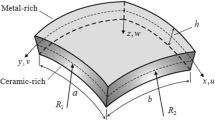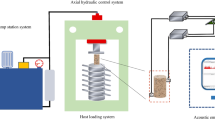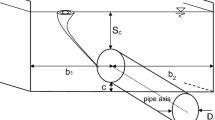Abstract
This study investigates the energy absorption of thin-walled tubes under dynamic axial crushing. The crush energy is known to be affected by the crush speed and geometry of the perforated tubes. The perforation geometry characterized by the size, shape, and array pattern of the holes was selected with respect to a square reference tube with equal mass. Tests and finite element analyses (FEAs) were performed in conjunction with the design of experiments (DOE). Relative to the reference tube, an average increase of 19.5% in energy absorption was achieved with a set of perforated tubes.




















Similar content being viewed by others
Abbreviations
- Δ :
-
Crush displacement
- δ max :
-
Terminal displacement
- \(\varepsilon\) :
-
Equivalent strain
- \(\dot{\varepsilon }\) :
-
Strain rate
- \(\dot{\varepsilon }_{p}\) :
-
Plastic strain rate
- η :
-
Crush force efficiency
- F :
-
Axial crush force
- F max :
-
Peak crush force
- F mean :
-
Mean crush force
- \(\sigma\) :
-
Equivalent Von Mises stress
- \(\sigma_{0.2}\) :
-
Material 0.2% proof stress
- T :
-
Thickness of tube
- \(w_{0}\) :
-
Initial imperfection amplitude
References
Tarigopula, V., Hopperstad, O. S., & Clausen, A. H. (2006). Axial crushing of thin-walled high-strength steel sections. The International Journal of Impact Engineering, 32(5), 847–882.
Abramowicz, W., & Jones, N. (1984). Dynamic axial crushing of square tubes. The International Journal of Impact Engineering, 2(2), 197–208.
Younes, M. M. (2009). Finite element modeling of crushing behaviour of thin tubes with various cross-sections. Proceedings of the 13th International Conference on Aerospace Sciences & Aviation Technology. 13(ASAT-13-ST-34).
Higuchi, M., Hamaguchi, Y., Suziki, S., & Adachi, T. (2012). Dynamic behavior of circular tubes subjected to high impact loading. Journal of JSME, 12, s127–s132.
Yang, C. C. (2003). Dynamic progressive buckling of square tubes. Proceedings of the 27th Conference on Theoretical and Applied Mechanics 1247–1255.
Kazancı, Z., & Bathe, K. J. (2012). Crushing and crashing of tubes with implicit time integration. The International Journal of Impact Engineering, 42, 80–88.
Zhang, X., & Huh, H. (2009). Energy absorption of longitudinally grooved square tubes under axial compression. Thin-Walled Structures, 47(12), 1469–1677.
Guler, M. A., Cerit, M. E., Bayram, B., Gerceker, B., & Karakaya, E. (2010). The effect of geometrical parameters on the energy absorption characteristics of thin-walled structures under axial impact loading. The International Journal of Crashworthiness, 15(4), 377–390.
Nia, A. A., & Hamedani, J. H. (2010). Comparative analysis of energy absorption and deformations of thin walled tubes with various section geometries. Thin-Walled Structures, 48(12), 946–954.
Isoldi, L. A., De Real, M.V., Vaz, J., Correia, A. L. G., Dos Santos, E. D., & Rocha, L. A. O. (2012). Numerical analysis of perforated thin plates subjected to tension or buckling. Proceedings of the International Conference on Offshore and Marine Technology 46–49.
Benzing, J. T., et al. (2018). Effect of strain rate on mechanical properties and deformation austenitic Fe-25Mn-3Al-3Si TWIP-TRIP steel. Materials Science and Engineering A, 711, 78–92.
Yang, X., Hector, L. G., Jr., & Wang, J. (2014). A combined theoretical/experimental approach for reducing ringing artifacts in low dynamic testing with servo-hydraulic load frames. Experimental Mechanics, 54, 775–789.
Alipour, R., Farokhi Nejad, A., & Izman, S. (2015). The reliability of finite element analysis results of the low impact test in predicting the energy absorption performance of thin-walled structures. Journal of Mechanical Science and Technology, 29(5), 2035–2045.
Isaac, C. W., & Oluwole, O. (2017). Numerical modelling of the effect of non-propagating crack in circular thin-walled tubes under dynamic axial crushing. Thin-Walled Structures, 115, 119–128.
Tang, T., Gao, Y., Yao, L., Li, Y., & Lu, J. (2018). Development of high-performance energy absorption component based on the structural design and nanocrystallization. Materials and Design, 137(5), 214–225.
Zhang, D. N., Shangguan, Q. Q., Xie, C. J., & Liu, F. (2015). A modified Johnson-Cook model of dynamic tensile behaviors for 7075–T6 aluminum alloy. Journal of Alloys and Compounds, 619(15), 186–194.
Vedantam, K., Bajaj, D., Brar, N. S., & Hill, S. (2005). Johnson-Cook strength models for mild and DP590 steels. Shock Compression of Condensed Matter, 845, 775–778.
Zhao, Y., Sun, J., Li, J., Yan, Y., & Wang, P. (2017). A comparative study on Johnson-Cook and modified Johnson-Cook constitutive material model to predict the dynamic behavior laser additive manufacturing FeCr alloy. Journal of Alloys and Compounds, 723(5), 179–187.
Segade, A., López-Campos, J. A., Fernández, J. R., Casarejos, E., & Vilán, J. A. (2016). Finite element simulation for analysing the design and testing of an energy absorption system. Materials, 9(660), 1–13.
Karagiozova, D. (2001). Inertia effects on some crashworthiness parameters for cylindrical shells under axial impact. The International Journal of Crashworthiness, 6(4), 561–572.
Alem, N., & Perry, M. (1995). Design of digital low-pass filters for time-domain recursive filtering of impact acceleration signals. Report No. 95–13. United States Army Aeromedical Research Laboratory (USAARL).
SAE. J211–1 Standard, Surface vehicle recommended practice, Rev. 03.2014.
Gardner, L., & Nethercot, D. A. (2004). Numerical modeling of stainless-steel structural components—a consistent approach. The Journal of Structural Engineering, 130(10), 1586–1601.
Xue, L., Lin, Z., & Jiang, Z. (2013). Effects of initial geometrical imperfection on square tube collapse. Technical report, Shanghai Jiao Tong University. 31–36.
Chou, S. M., Chai, G. B., & Ling, L. (2000). Finite element technique for design of stub columns. Thin-Walled Structures, 37(2), 97–112.
Xiong, Z., Huang, Z., Yu, X., & Guo, J. (2019). Application of random geometric imperfection method to nonlinear buckling analysis of spherical shell. The Journal of Marine Science and Technology, 27(1), 28–34.
Author information
Authors and Affiliations
Corresponding author
Additional information
Publisher's Note
Springer Nature remains neutral with regard to jurisdictional claims in published maps and institutional affiliations.
Rights and permissions
About this article
Cite this article
Kim, JH., Cho, DH., Choi, SU. et al. Energy Absorption of Square Tubes with Perforations in Dynamic Axial Crush. Int. J. Precis. Eng. Manuf. 22, 567–577 (2021). https://doi.org/10.1007/s12541-020-00456-z
Received:
Revised:
Accepted:
Published:
Issue Date:
DOI: https://doi.org/10.1007/s12541-020-00456-z




